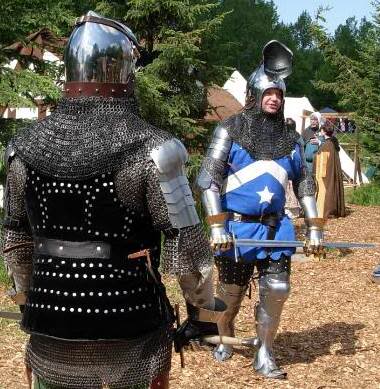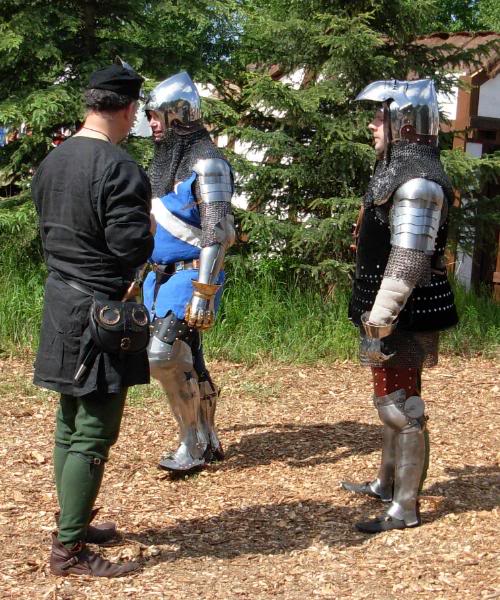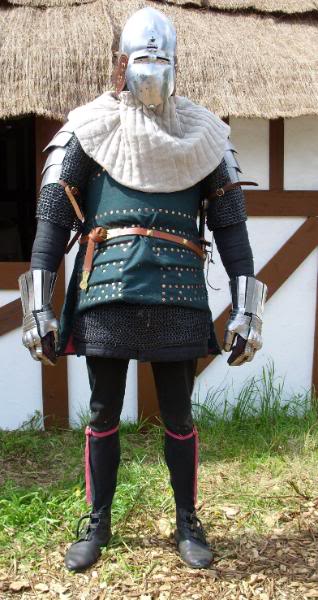I am looking for information about corrazinas, or goblose-breasted coat-of-plates (I understand that the term corrazina is a bit debatable). I have seen a couple of wonderful pictures of people wearing them but I can't seem to find any information about them. When did they first appear? When did they fall out of favour and disappear? Who used the? The highest nobility or the somewhat lower class? Both? What's the outer material made of? Are there any extant pieces besides this one in Milan?
And of course, where would I be able to buy one? All I found is this one at Oaks Armoury but the website doesn't list any prices, not does it seem to have been updated since 2005 or so.
I just love the look of this type of armour. Pictures most definitely welcome so I have something to drool over :D
These have been discussed here before. The Search function should help. :)
| Chad Arnow wrote: |
| These have been discussed here before. The Search function should help. :) |
I tried, but I only got back about 10 threads or so. They all mention or have a few pictures of a corrazina but pretty much no additional information. All I can glean from the pictures is "late 14th century". Am I spelling corrazina right?
I get search results for "corazzina," "corrazzina," and even 1 for "corazina." Your spelling gets the most results, but all are worth checking. :)
Corrazina is a pretty generic term that is applyed to many diferent styles armour. In fact it's a type of armour made from several metal plates, held together by a flexible material but there are different styles of doing that. I believe that because of this, there is so less information about this type of armor. The different styles of armor are often considered different types of armor so it is possible to find a corrazina type armor called differently :).
| Sander Marechal wrote: |
| I am looking for information about corrazinas, or goblose-breasted coat-of-plates (I understand that the term corrazina is a bit debatable). I have seen a couple of wonderful pictures of people wearing them but I can't seem to find any information about them. When did they first appear? When did they fall out of favour and disappear? Who used the? The highest nobility or the somewhat lower class? Both? What's the outer material made of? Are there any extant pieces besides this one in Milan?
And of course, where would I be able to buy one? All I found is this one at Oaks Armoury but the website doesn't list any prices, not does it seem to have been updated since 2005 or so. I just love the look of this type of armour. Pictures most definitely welcome so I have something to drool over :D |
Hello Sander ,
As I understand it, the "corrazina" came about in the later part of the 14th century during that groovy cool time know as the transitional age of armour. By 1420 they had been eclipsed by the white harness or the Brigantine and had fallen out of favor.
The Milan piece is mis-marked as it's not a14th century "corrazina" but a 15th century one of a kind garment.
The 14th century "corrazina" was covered with a flax canvas base for strength and covered with a decorative cloth cover. Silk velvets, linen, or a brocade could be used. Today's groups like the SCA often use leather instead of cloth to make a "corrazina" last longer.
There is a nice "How to make a" on the "corrazina" by Doug Strong of the Armour Society on his website (Talbots) and it's just a few bucks.
Here is a very small part of the intro of his pdf that answers a few of your questions:
"There are numerous surviving elements from what are commonly called the corrazina. By
my count there are seventeen surviving breastplate halves for this type of armour and a dozen upper
backplates. The most complete example is on display at the Metropolitan Museum of Art in New
York (#29.154.3). This example is complete because Dr. Bashford Dean assembled it out of
disparate parts not because it survived as a complete harness. Nevertheless, this is the harness we
think of when we think of a corrazina. This corrazina is heavily restored and even the Metropolitan
Museum has no idea which of the plates in this cuirass are restorations. Unfortunately it would also
appear Dr. Dean made some errors when he created this armour. The most noticeable error was in the
form of the fauld. Dean’s fauld is made up of rectangular plates rather than hoop lames. There is very
little evidence for this though it compares favorably to a figure in the beheading of St. James in the
altarpiece in Pistoia Cathedral. The most likely fauld for this type of body armour would have been a
standard fauld of hoops. This is the type of fauld typically illustrated in art such as Altichiero’s 1385
Beheading of St. George or the 1430 portrait of St. Domitian in Stiftskirche Millstatt."
A Corrazina Circa 1380-1420
TECHNIQUES OF CONSTRUCTION
By Douglas W. Strong
HISTORICAL RESEARCH PRESS
© Copyright 2009, Douglas W. Strong
This is well worth the price. How do I know? I made this "corrazina" from Doug's pattern.



It's a mix of 16 ga, 18ga, and 20 ga (with the 20 ga being heat tempered) steel with a flax canvas base and a black silk velvet cover. It is dead sexy.
We also made a second "corrazina "that was inspired by... the mis-marked 15th century Milan garment (Doh!) It has riveted maille in the back ( like Milan garment) but differs in the front a bit with more of a 14th century style of breast plate and secondary plates.

My hands were killing me from so much hammering over a 6 week period to get both "corrazinas" done for this event.

In closing, in 1380 they would have been used by the knights or those men at arms with good incomes. As the 14th century closed I'm sure the older ones would have been used by " poor" lesser knights and men at arms as those who could keep up with the changing fashions of armor switched to the full white harmess. By 1420, they were outdated and passed by with the better tailored cloth based Brigantine.
Cheers,
David
Thanks David. I saw those pictures before in the "Let's see you kit..." thread and they are awesome. It's what inspired me to look into this kind of armour :) But I didn't realise that you made these yourself!
A few questions if you don't mind.
Are they hard to make? I don't have any armouring experience, nor any equipment for it. From the looks of your corrazina I think it would involve dishing out or raising a cuirass. That's probably not such a good first project :)
Are they expensive to make?
Also, is your black corrazina split up the front? I can't really tell from the pictures you posted. If you happen to have a picture that clearly shows the front of the black corrazina I'd be happy to see it.
Thanks in advance!
A few questions if you don't mind.
Are they hard to make? I don't have any armouring experience, nor any equipment for it. From the looks of your corrazina I think it would involve dishing out or raising a cuirass. That's probably not such a good first project :)
Are they expensive to make?
Also, is your black corrazina split up the front? I can't really tell from the pictures you posted. If you happen to have a picture that clearly shows the front of the black corrazina I'd be happy to see it.
Thanks in advance!
Hello Sander,
I helped make the two corrazinas but neither belong to me so new pictures are a bit hard. To answer the question posed, yes it splits up the front.
(Here is the pic from Doug's great instructions)
[ Linked Image ]
While I'm not really an armourer (I only play on on TV ;) ) I do have some light armouring tools, an anvil, hand shears, and some hammering skills from hanging out at a blacksmithing shop for a year when unemployed as a free helper.
They weren't too expensive to make other than the silk velvet (which was somewhere around $100 for the fabric) and a riveted maile shirt that we cut up for the Milan inspired piece($220) The Milan inspired piece used scrap fabric and used steel from a old hot water heater to otherwise lower it's overall cost.
Both guys probably spent around 300 in materials for their armour and 100 hours of hand labor each. ( I did a lot of the sewing, hammer work and rivet work with them helping me, but each was a group project).
There is a armourer (Cet) who will cut and shape armor for you and you do the finish work. His company? The aptly named Rough from the Hammer. If I was going to build a corrazina and lacked the basic tools I'd look into having him cut the pattern out and shape it for me and use Doug Strong's pattern as the instructions and design.
Most of the corrazinas"out there for sale aren't that close to historical, they copy the mistake with the faulds of the Met reconstruction or they push a 1000 dollars or more (and can still suffer the above problems).
Cheers,
David
I helped make the two corrazinas but neither belong to me so new pictures are a bit hard. To answer the question posed, yes it splits up the front.
(Here is the pic from Doug's great instructions)
[ Linked Image ]
While I'm not really an armourer (I only play on on TV ;) ) I do have some light armouring tools, an anvil, hand shears, and some hammering skills from hanging out at a blacksmithing shop for a year when unemployed as a free helper.
They weren't too expensive to make other than the silk velvet (which was somewhere around $100 for the fabric) and a riveted maile shirt that we cut up for the Milan inspired piece($220) The Milan inspired piece used scrap fabric and used steel from a old hot water heater to otherwise lower it's overall cost.
Both guys probably spent around 300 in materials for their armour and 100 hours of hand labor each. ( I did a lot of the sewing, hammer work and rivet work with them helping me, but each was a group project).
There is a armourer (Cet) who will cut and shape armor for you and you do the finish work. His company? The aptly named Rough from the Hammer. If I was going to build a corrazina and lacked the basic tools I'd look into having him cut the pattern out and shape it for me and use Doug Strong's pattern as the instructions and design.
Most of the corrazinas"out there for sale aren't that close to historical, they copy the mistake with the faulds of the Met reconstruction or they push a 1000 dollars or more (and can still suffer the above problems).
Cheers,
David
I followed Stanislav Prosek's link to check out the messer, and saw what you appear to be looking for in his "in stock" page.
Follow the link: http://www.mac-armour.cz/index_en.htm
There's also pictures of the in stock item, and an example of one in black, under his 14th century gallery.
At current rates, the available item prices out to about 470 Euro.
Follow the link: http://www.mac-armour.cz/index_en.htm
There's also pictures of the in stock item, and an example of one in black, under his 14th century gallery.
At current rates, the available item prices out to about 470 Euro.
| Victor R. wrote: |
| I followed Stanislav Prosek's link to check out the messer, and saw what you appear to be looking for in his "in stock" page.
Follow the link: http://www.mac-armour.cz/index_en.htm There's also pictures of the in stock item, and an example of one in black, under his 14th century gallery. At current rates, the available item prices out to about 470 Euro. |
3 possible problems.
#1. Met style faulds (keeps you from sitting down or riding a horse)
#2 He's not taking orders at this time. ("Dear customers, because of number of accepted orders I am not able to accept next order untill rescission".)
#3 470 Euro= $640 plus shipping
Edit: he has one in stock for $637.433 sizing unknown.
Thanks for the information. Having the metal pieces custom made and doing the assembly myself is a great idea. Riveting is something I can learn :D
| Sander Marechal wrote: |
| Thanks for the information. Having the metal pieces custom made and doing the assembly myself is a great idea. Riveting is something I can learn :D |
Yep, I've done a ton of riveting in my time, it's not hard, just time consuming.
Since we wanted to make our as historical as possible, we used period fabrics, rivets and buckles. If you don't have such a need, a SCA type leather shell, modern buckles and modern double cap rivets work just fine, speed construction, and still produce a spiffy looking item.
If you ever start one, just ping me for helpful tips and pointers (plus Doug Strong answers e-mails when folks need tech support).
Cheers,
David
Thanks David, I'll be sure to ping for help by that time.
I don't know yet exactly how historically accurate I will be. It's a balancing act between accuracy and cost. Period-looking buckles and rivets do not seem to be prohibitly expensive but I have no idea yet how expensive period fabrics are.
I don't know yet exactly how historically accurate I will be. It's a balancing act between accuracy and cost. Period-looking buckles and rivets do not seem to be prohibitly expensive but I have no idea yet how expensive period fabrics are.
@ David!
How is the basic plan for that brigandine? Is it a breastplate sawn into the brig. and then som plates in lower parts?
Looks very interesting and I have a old brestplate I could use to make a simmilar one.
How is the basic plan for that brigandine? Is it a breastplate sawn into the brig. and then som plates in lower parts?
Looks very interesting and I have a old brestplate I could use to make a simmilar one.
| Martin Wallgren wrote: |
| @ David!
How is the basic plan for that brigandine? Is it a breastplate sawn into the brig. and then som plates in lower parts? Looks very interesting and I have a old brestplate I could use to make a simmilar one. |
@ Martin!
If you're talking about the the Milan inspired piece the maille on the back is sewn to the fabric shell, all plates are held in place by rivets and washers.
On the black corrazina I sewed a black dyed deerskin edging to protect the fabric from chafing and a band of black deerskin on the the back (you can see it in one photo) where there seemed to be way too much tension on the fabric shell.
Otherwise, all plates are riveted to the fabric shells of both..
@ Sander.
Fabric (linen, canvas, wool) is cheaper than leather if you shop online . Copper or steel nails are much cheaper than the 2 piece modern rivets (but you have to match washers to fit the nails... only the modern buckles are cheaper than reproduction buckles.
Leather has a longer life span if worn often, the 2 piece modern rivets "rivet" much faster and easier than an "arming nail".
Cheers,
David
Go with nails whenever possible. The riveting takes some time, but there are much less rivets in the covered globose breast and fauld compared to a 15th cent brig. It is doable and not really difficult.
I would recomend zinc coated flathead nails. The group I am with made an experimental batch of iron nails with a tin coating using a method that would have been doable in the 14th c, and the only way we could tell the diference once they were made up was that one made my fillings tingle when I chewed on it. So unless you are planning on having someone bite you while in harness the zinc nails have a very high level of historicity.
Page 1 of 1
You cannot post new topics in this forumYou cannot reply to topics in this forum
You cannot edit your posts in this forum
You cannot delete your posts in this forum
You cannot vote in polls in this forum
You cannot attach files in this forum
You can download files in this forum
All contents © Copyright 2003-2006 myArmoury.com — All rights reserved
Discussion forums powered by phpBB © The phpBB Group
Switch to the Full-featured Version of the forum
Discussion forums powered by phpBB © The phpBB Group
Switch to the Full-featured Version of the forum